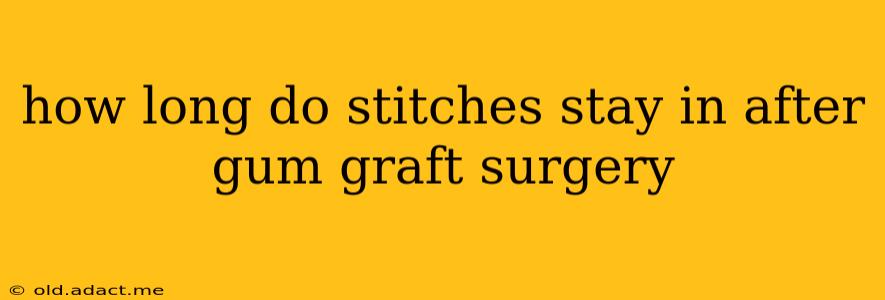Gum graft surgery, a common procedure to address gum recession and improve oral health, often involves the use of stitches to secure the grafted tissue. A frequent question patients have is, "How long do stitches stay in after gum graft surgery?" The answer, unfortunately, isn't a simple number of days. The healing process and stitch removal timeline vary depending on several factors. Let's delve into the specifics.
What Determines How Long Stitches Remain?
Several factors influence how long your stitches will remain in place following a gum graft:
- Type of Stitch: Different types of stitches dissolve on their own (resorbable sutures), while others require removal by a dentist or periodontist (non-resorbable sutures). Resorbable stitches typically dissolve within a few weeks, while non-resorbable ones usually need to be removed after 7-14 days.
- Location and Severity of the Graft: Larger or more complex grafts may require longer healing times and thus, stitches might stay in for a bit longer. The location of the graft within your mouth can also influence healing.
- Individual Healing Rate: Just as with any surgical procedure, individual healing rates vary considerably. Some patients heal faster than others.
- Post-Operative Care: Diligent adherence to post-operative instructions, including proper oral hygiene and avoiding irritants, significantly impacts healing and stitch retention.
How Long Do Resorbable Stitches Last?
Resorbable stitches, designed to dissolve naturally within the body, are commonly used in gum graft surgeries. The exact timeframe for dissolution varies depending on the type of suture material used, but generally, they'll dissolve within two to four weeks. You might notice them gradually disappearing or possibly a small amount of material remaining, which is usually harmless and will eventually be absorbed.
How Long Do Non-Resorbable Stitches Last?
Non-resorbable stitches require removal by a dental professional. Your dentist or periodontist will schedule a follow-up appointment approximately 7 to 14 days after the surgery to remove these stitches. This timeframe allows for adequate initial healing and minimizes the risk of complications.
What Happens During Stitch Removal?
Stitch removal is a quick and relatively painless procedure. Your dentist or periodontist will carefully snip the sutures and remove them gently. You may experience minimal discomfort or a slight tugging sensation during the process, but it's usually brief and well-tolerated.
What if My Stitches Come Out Early?
If a stitch falls out prematurely, don't panic. Contact your dentist or periodontist immediately to discuss this. While it's usually not a major concern, early stitch removal might slightly impact the healing process, so it’s crucial to let your dental professional assess the situation.
Will I Need Pain Medication After Stitch Removal?
Pain medication after stitch removal is typically not necessary. However, some minor discomfort or sensitivity may persist at the surgical site. Over-the-counter pain relievers, such as ibuprofen or acetaminophen, can help manage any lingering discomfort.
What Should I Expect After Stitch Removal?
After stitch removal, the gum tissue may still appear slightly swollen or tender. Follow your dentist's post-operative instructions carefully to ensure proper healing. Maintain meticulous oral hygiene, avoiding harsh brushing or flossing near the surgical site. A gentle rinse with saltwater can help keep the area clean.
Disclaimer: This information is for general knowledge and does not constitute medical advice. Always consult with your dentist or periodontist for personalized advice regarding your gum graft surgery and post-operative care. They can accurately determine the type of stitches used, anticipated healing time, and when stitch removal is necessary for your specific case.
